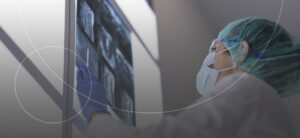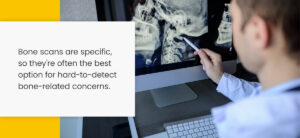
When a patient has bone pain, their doctor might order a bone scan. A nuclear bone scan uses radiotracers, which are small amounts of radioactive substances, to recognize differences in bone metabolism. With the help of these radiotracers and a specialized camera, physicians can diagnose various bone issues, from infections to arthritis.
What Is a Nuclear Bone Scan?
If you’ve talked to your primary care doctor about continual bone pain or seen an emergency room physician about a potential fracture, you may need a nuclear bone scan. A bone scan requires a few different components, which reveal whether any irregularities are present.
There are two parts to a bone scan:
- Injection: The injection places a small number of radiotracers into a patient’s bloodstream through a vein. Depending on why the patient needs a bone scan, the scan may not take place right after the injection. Typically, patients must wait a few hours to allow the radiotracers to absorb into their bones.
- Scan: After waiting the allotted time and following the doctor’s instructions, which usually require urinating before the scan to remove unabsorbed radiotracers, the scan can begin. The patient lies on a table while a specialized camera painlessly traces their body to analyze issues with bone metabolism. These differences appear as light or dark spots in the images.
Further, three main kinds of bone scans exist:
- Full-body bone scan: A full scan of your body may be necessary to detect issues throughout your body, such as a bone infection.
- Limited bone scan: This is a general scan used when whole-body bone diseases like cancer aren’t a concern.
- Triple-phase bone scan: Depending on the reason for the scan, you might need a three-point scan, which involves three stages of imaging — during the injection, immediately after the injection and a few hours later.
After the scan, you’ll likely need to increase your water intake to completely remove the radiotracers from your body over the following days.
A nuclear bone scan shows light and dark spots from the radiotracers, which radiologists will find in the images. Any dark spots indicate a contrast in bone metabolism, which could require further testing.
Nuclear Bone Scan Side Effects
A nuclear bone scan rarely presents side effects. Those that occur are mild and pass quickly. Additionally, no follow-up care is required after the scan aside from increasing your hydration to remove the leftover radiotracers.
The one potential risk to note is radiation. People who are pregnant or nursing shouldn’t undergo nuclear bone scans due to the chance of radiation exposure to the baby. If you could be pregnant, you may be required to take a free pregnancy test before your scan to ensure you’re not. Overall, nuclear bone scans present very little radiation exposure — you can compare the amount to a standard X-ray.
In almost every case, a nuclear bone scan is a safe procedure with no side effects.
Common Uses of Nuclear Bone Scans
The main benefit of a nuclear bone scan is the ability to identify various conditions and diseases, such as the following:
- Metastatic cancer: This is the most common use of a nuclear bone scan. During a scan, the radiotracers will highlight cancer cells as dark spots, helping doctors identify the spread of a patient’s cancer.
- Infections: Some infections, such as a bacterial bloodstream infection, can impact bone tissue by causing inflammation or swelling. This is known as osteomyelitis. If a patient shows signs of a bone infection, their physician may order a bone scan to detect it and analyze the situation.
- Arthritis: There are more than 100 types of arthritis, meaning doctors must learn more about a patient’s condition when they have arthritis. Whether someone could have arthritis or already has a diagnosis, a bone scan can help provide more information about their bone health.
- Fractures: If other methods like X-rays don’t reveal a fracture but one is expected, a bone scan can help locate the site of the fracture. When a patient has a fracture but doesn’t know when it happened, they might undergo a bone scan to help their physician determine the age of the fracture.
- Unexplained bone pain or trauma: A patient might have bone pain in one or more areas of their body. If their physician can’t find the source through other analysis options, they could order a nuclear bone scan to help them further understand the situation.
These examples are only a few reasons why your doctor might call for a nuclear bone scan. Any kind of bone-related health issue could warrant a scan. The decision to schedule one depends on your personal situation and your physician’s recommendations.

Is a Nuclear Bone Scan Beneficial?
Yes, a nuclear bone scan can be highly beneficial in detecting and assessing certain bone health problems. While other imaging solutions like computerized tomography (CT) scans are still advantageous because of their accuracy, bone scans are specific, so they’re often the best option for hard-to-detect bone-related concerns. An X-ray might identify an issue, but a bone scan can go deeper to provide crucial details on the situation.
Further, nuclear bone scans are painless and noninvasive and rarely come with side or after effects. These scans only require injecting the radiotracers, waiting for them to accumulate and lying down for around an hour to take the various images. For younger patients and claustrophobic patients, other means of scanning can be difficult and uncomfortable.
While you may need further imaging tests to locate the source of your bone pain, a nuclear bone scan is generally a simple process. This test can assist your doctor with making informed decisions about your health and potential treatment options. If your physician orders a bone scan, rest assured the process will be straightforward and provide comprehensive insight into your bone health.



